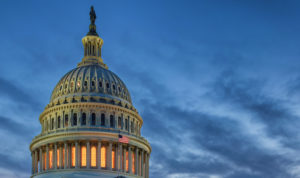
The challenges facing today’s federal blended workforce calls for a reprise of the Volcker Commission.
Paul C. Light is an intellectual giant on whose shoulders discerning American public administration scholars are proud to stand. Over the last four decades, Light has uncovered hidden truths about how American government actually works, discovered practical ways to improve government performance, and rallied influential public leaders to help reform the government bureaucracies that translate democratically enacted laws into actions.
The lessons that Light offers in “Silver Linings Shutdown” synthesize the wisdom contained in his latest seminal book, The Government-Industrial Complex: The True Size of the Federal Government, 1984-2018. In a foreword to that book, Paul A. Volcker, the former Federal Reserve Board Chairman who, in 1990, with Light’s help, launched the National Commission on Public Service (a.k.a., the Volcker Commission), writes:
Light’s analysis emphasizes the importance of how people working under the aegis of the federal government are selected, compensated, and managed… The evident decline in trust in government…is silently but pervasively weakening the foundation of our society… Light sets out the substance of what is required for real and lasting reform… His book should be required reading for every member of Congress and president seriously interested in effective government… It’s time to pay attention.
Amen. We ought to pay special attention to Light’s lessons about the “blended workforce,” and conclude with him that a plan is needed to end our “quiet crisis” and turn “a once-in-a-generation chance to remake the federal service” to good and lasting account.
Light spotlights “the private and nonprofit sector employees who provide goods and services to the nation under federal contracts and grants.” He estimates that at the start of the last shutdown, “the federal government employed about 7.2 million federal, contract, and grant employees,” six million of whom worked for departments affected by the stoppage. He emphasizes how the shutdown brought “the federal government’s blended workforce” into the media spotlight and before the public mind.
As usual, Light is absolutely right. At least for a brief and shining shutdown moment, journalists and citizens learned that full-time federal bureaucrats were not Washington’s sole and sufficient workforce. They wrote or read headlines about the economic and other hardships suffered not only by furloughed federal bureaucrats but by other flesh and blood fellow citizens who work on contract for the federal government. And they got a crash course in how much Americans rely on both bureaucrats and contractors, not only for tax refunds and the like, but also “for a host of benefits that keep them safe,” such as food and drug safety and aircraft inspections.
To Light’s silver-linings list on the blended workforce, I would only add shutdown-related stories that stumbled across the fact that about 80 percent of our full-time, federal civilian employees actually live, work, worship, and shop outside the Washington, D.C. region—just like the vast majority of all U.S. Postal Service workers who deliver the mail. Indeed, just like most Americans, period.
Since the last federal government shutdown, we have learned that federal contract spending grew 9 percent from 2017 to 2018. In 2018, it totaled $559 billion, which was the biggest total since 2010 when contract spending reached $562 billion. Defense, Energy, and Homeland Security led the increased contract spending parade. The biggest contract companies were once again Defense favorites such as Lockheed Martin and Raytheon. Meanwhile, IRS-registered nonprofit organizations, most notably both secular and religious human services public charities, continued to rely on government grants and fees for services for about a third of the total revenues with which they paid workers and did good works.
There are two overarching operational facts about present-day American government that cannot be ignored. One fact is well-known and much-discussed—namely, that ours is now a deficit-budgeted, debt-financed republic. The other fact, still little understood and often hardly noticed, is that federal laws and policies are executed not solely or even mainly by full-time federal bureaucrats, but by what Light terms the blended workforce. That workforce is flanked by a hard-to-specify but nontrivial number of state and local government employees whose positions are paid in whole or in part from the federal treasury, and whose jobs involve administering federally mandated programs. The blended workforce plus the de facto federal workers in state and local government agencies together staff America’s “shadow bureaucracy” or “Leviathan by proxy”—or whatever moniker one might wish to give it.
Ironically, the only part of the blended-plus federal government workforce that has not grown over the last half-century is the part that most Americans think is bloated or worse: the roughly two million full-time federal civilian workers. These are the unduly maligned “Washington bureaucrats” who, as Light aptly summarizes, have been caricatured as overpaid and underworked when they are, in fact, and for the most part, “real people who clock in every day to make a difference for their communities and country.” The nearly $600 billion spent on federal contractors in 2018 was more than twice what the federal government spent that year on the wages and benefits of all two million or so full-time federal civilian workers.
But almost nobody knows that or seems to care, except, maybe, when the federal government shuts down. The three “good government groups” that Light references in his penultimate paragraph (the Volcker Alliance, the National Academy of Public Administration, and the Partnership for Public Service) should join forces with universities, think tanks, and other good-government organizations (like, for example, the Brookings Center for Effective Public Management and Harvard’s Innovations in American Government Program, to cite just two).
Here is plumping for a new, Light-directed national commission on—to steal his book title for the purpose—“The Government-Industrial Complex.” Led by Light, such a commission’s central, if not its sole, mission, would be to document the true size of the federal government, develop a big data-gathering system for describing and assessing the blended-plus workforce, and devise measures intended to revitalize and reform that workforce’s nucleus—the federal civil service system.
Next year, 2020, marks the Volcker Commission’s 30th anniversary. In spring 2020, the University of Pennsylvania Press will be releasing an edited volume celebrating Chairman Volcker’s legacy and featuring a chapter by Light. Perfect timing for a conference in Philadelphia to launch that Light-directed commission! I, for one, would do all I could to advance it. A national, high-impact, Light-directed commission that shines searching lights on the true size of government, and creates a system for keeping them shining, would be more than a shutdown silver lining. It would be pure civic gold.
This essay is part of a five-part series, entitled What the Shutdown Revealed About the Value of Public Service.




